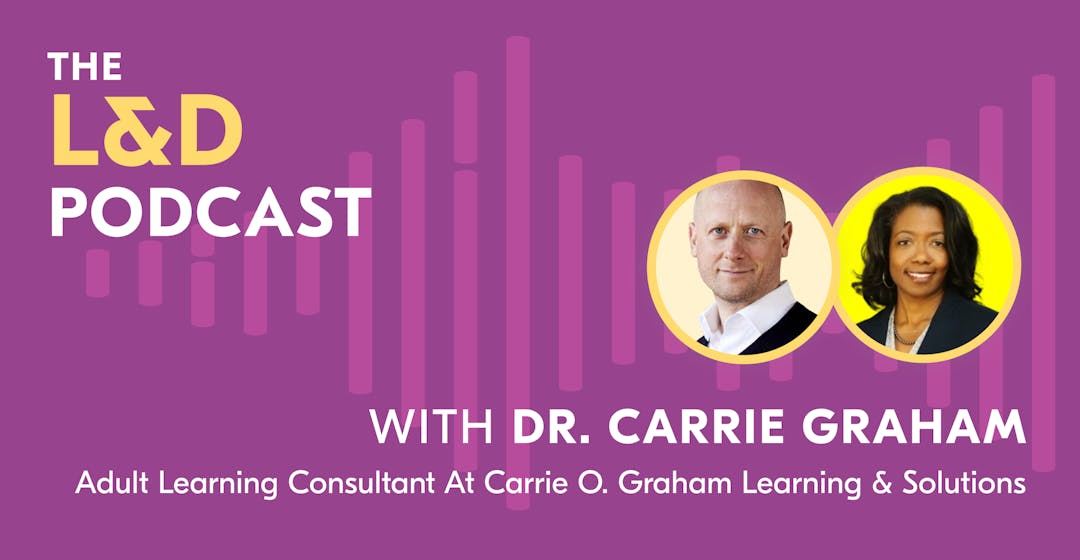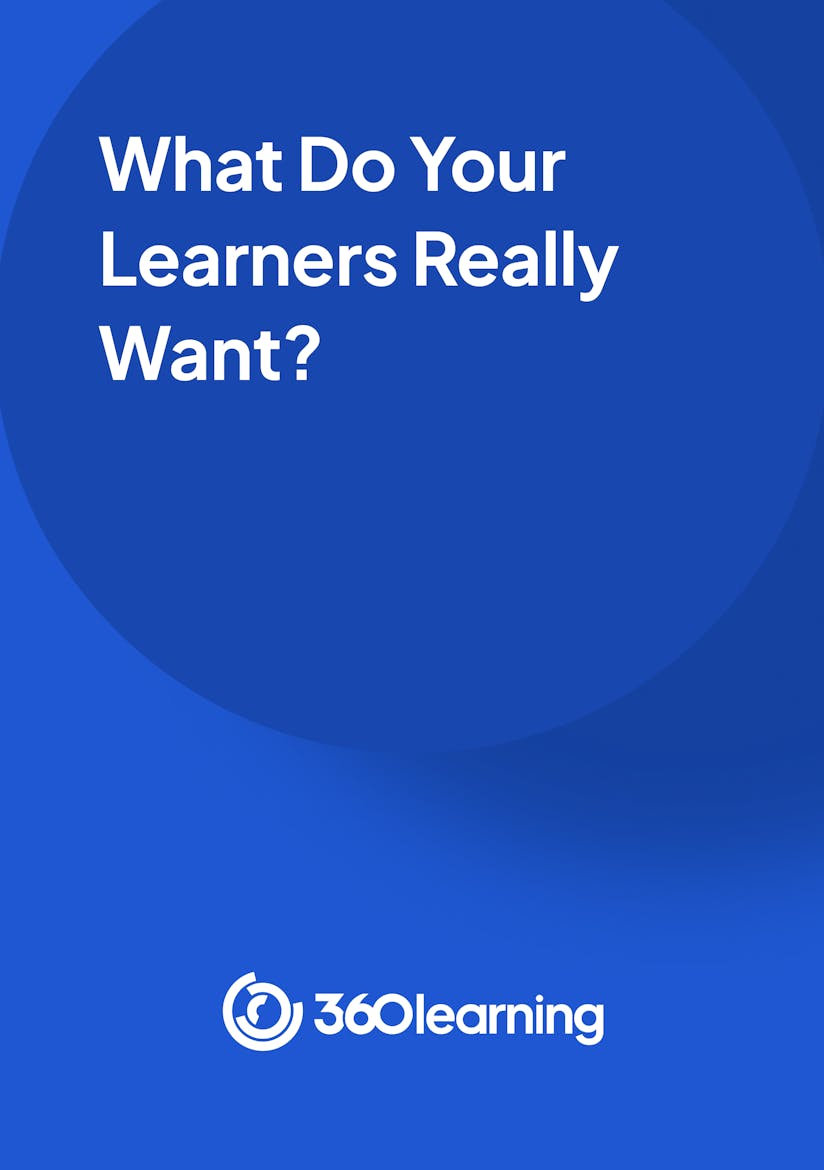
Why Life Experience Impacts Learning: Adult Learning Theory Explained by Dr. Carrie Graham
Learner engagement, knowledge retention, skills application. These three L&D priorities grab most L&D professionals' attention immediately.
But what if we were to say that some L&D teams might be missing out on an opportunity to significantly impact these outcomes because they’re looking at the learning experience from the wrong perspective?
In this podcast recap, I speak with Dr. Carrie Graham (check out the full episode here), Owner of Carrie O. Graham Learning & Solutions, as we explore how Adult Learning Theory can help you make a measurable impact, starting with understanding who your learner is.
Read on to hear why Adult Learning Theory is crucial to L&D practices, how life experience impacts adult learning, and practical steps from Carrie on how she uses Adult Learning Theory to ramp up skill development pipelines.
Loving what you’re reading? Come and join the L&D Collective for more great learning insights, resources, and events!
Why understanding your learner is crucial to Adult Learning Theory
As Carrie explains, Adult Learning Theory is crucial to achieving the three outcomes mentioned.
“My work focuses on improving the adult learner engagement, supporting their information retention, and accurately applying the skills they've learned,” she says.
In over two decades of experience, Carrie has seen that some L&D professionals have a basic understanding of adult learning and are working to incorporate it into their learning strategies.
“However, the vast majority of people working in the L&D space, whether they’re identifying themselves as such or not, aren’t acknowledging who the learner is or who their audience is as a learner,” she explains.
So, this is the very first conversation Carrie has with her clients. They work together to understand the learner so that they can build the learning or development experience toward the learner.
“If someone were to ignore that we have different experiences or visual needs,” she says, “they're negating an entire element of who we are, and therefore it actually increases the likelihood of disengagement.”
Carrie advocates ensuring L&D leaders engage the learner because if they are involved in a meaningful way, they will retain the information. “And if they're retaining the information, they're more likely to apply whatever the knowledge or the skillset is,” she says.
Looking for more tips on understanding what your learners really want? See what 600 learners had to say in our report.

We surveyed 600 learners. This is what they said.
By providing your contact info, you agree to receive communications from 360Learning. You can opt-out at any time. For details, refer to our Privacy Policy.
Pedagogy and andragogy, a distinct difference
Carrie goes on to say that there is a distinct difference between pedagogy and andragogy, which comes down to life experience and how it impacts learning.
“Often, people in the L&D space work from a place of what they've experienced or seen. This is often your typical classroom training where the audience all face forward with one individual in the front who is the all-knower of knowledge. That is a nod to pedagogy and how we teach children,” she says.
But what we must remember is that children don’t have lengthy life experiences which typically impact learning—however, adults do.
“So, that environment of let's all face forward, sit still and consume information doesn't work for the vast majority of adults,” says Carrie.
Instead, adult learning thrives in an informal setting. Retention and application happen when adults are provided with real-life experiences that they can draw on to navigate the space or solve problems—mentoring or leadership programmes are just two examples of informal learning that work.
That environment of let’s all face forward, sit still and consume information doesn't work for the vast majority of adults.
“With this approach, when adults use the new skill set or apply the new knowledge, they are doing it in real time. They're also trying to understand how to use this new piece of information to achieve a very specific goal or outcome,” she says.
“So, when L&D organizations or professionals are creating their learning experiences, I firstly, advocate for understanding who these people are as learners. Then, I recommend strategically designing the experience to place them in the environment where they need to use those skills. That's what's going to drive the retention and the application,”
Related: What is Adult Learning Theory and How Can You Apply It?
Adult learning, a turning point
A story Carrie always shares about her turning point in adult learning highlights the importance of understanding the adult learning experience.
At one point in her career, Carrie worked for a state agency, where there was mandated annual sexual harassment training. “So, I'm in an auditorium with individuals from all segments of this organization, and I remember looking around at the people seated closest to me. Some were asleep. Some were playing games on their phones.”
“The organization was still in a very public legal battle around sexual harassment. And that was one of the many things that did it for me in saying that clearly, something is not right as it relates to how those educational experiences are being presented,” she says.
Looking down the line, Carries explains it has a significant financial implication. Money spent on training fell flat because people were unengaged, and the organization was in litigation around the very topic presented year after year. The result is a high financial and reputational cost.
“The use of adult learning theory that I use is simplistic,” Carrie explains. “There are instances where we need to dig deep, and it's used at a high level, but for the average business or organization, simply considering the basic assumptions about who adult learners are is key.”
“For those L&D organizations or departments that are well developed, I encourage them to take a deeper look at how we can really leverage the use of adult learning theory in our current work. It's not to say let's clean house and flip things on its head, but how we can enrich the work that we're doing,” she says.
Related: How People Really Learn—And What it Means for L&D Teams—With Nick Shackleton-Jones
Implementing Adult Learning Theory
When thinking about design, in Carrie’s experience, once you’ve considered the adult learner, it is time to dig into the data.
“When we are thinking about the design and construction, that's where it takes some finesse. Does this person have knowledge of the subject already? If they do, we can review the basic tenants and present more progressive information. If it's an audience who is well versed in the topic, we jump right in.”
However, when Carrie finds a mixed audience, and she’s unsure of their knowledge base and skill set, she offers a fundamental review of the information or skill so that L&D practictioners can layer the information and complexity in a way that supports the learner.
“I would also advise L&D teams to incorporate opportunities for problem-solving,” she says. “If you do that, you're the reinforcement of the learning and comprehension, but you're also giving the learner opportunities to practice and apply the information or the skillset.”
In Carrie’s experience, using this approach increases the likelihood of getting your anticipated return. “Without that, you're really taking a stab in the dark without the answers to the questions: Will learners remember what we've presented to them? Will they apply the skill? Will they actually apply the skill accurately?”
Incorporate opportunities for problem-solving in your training. If you do that, you're reinforcing learning and comprehension, but you're also giving the learner opportunities to practice and apply the information or the skillset.
When designing adult learning, it is crucial to build in a way that supports learners and the comprehension of information, and at the end is the opportunity for analysis.
“The quantitative assessment is critical,” Carrie says. “The qualitative feedback is helpful, but if you're thinking long-term, using a quantitative assessment of learning is absolutely mandatory.”
Related: The Early Adopter Phase is Over: An L&D Data and Analytics Deep Dive with Trish Uhl
Using adult learning to close skills gaps
According to Carrie, solving skill gaps starts by considering the outcome and looking at where the audience is in their career life cycle.
Carrie finds that if you think about Adult Learning Theory and how to leverage it to close skill gaps, you need to think about what outcome you want and what you need to do from a systemic perspective to help support that skill development pipeline.
“So if we're thinking about common skills gaps like leadership, training and teaching, I argue, let's go back to the beginning, but let's change who the audience is. Let's look at early career individuals. Who are they as learners? How can we support them? How can we support their skill development in the pipeline mid-careers?
These mid-career people are the ones who are having shifts in their social roles and are thinking about their careers from different perspectives. Therefore, their internal motivation for either upskilling or maintaining skills changes.
“But if you are not acknowledging that this is a generation of people who want to retire early, or they're only working to put their kids through college, again, you're negating the fact that their interest in learning new skills is waning. So, how can you leverage that?”
In Carrie’s experience, the same holds true for executives. “I would argue the motivation for an executive attending a training is very different than someone who's early in their career. So if you want to upskill those individuals or provide them with new skills in general, you again have to look at them for who they are at that moment.”
Are you excited about implementing Adult Learning Theory in your L&D practice today? Great, Carrie has some expert advice on where to start.
Getting started today
Carrie reiterates that the first thing to do is consider who your audience is and then think about who they are as learners.
Here is a simple way to look at it. Your ideal client or employee staff are people you have invited to a dinner party. A conversation sparks up about what a thermos is. The definition will be different because you might have someone who is a thermos expert and someone else who has never seen a thermos.
“So again, if you can appreciate who your audience is as a learner, that is the very best place to start,” Carrie says. “And if you've done that already, then as you're building your content, reference back to who they are as a learner, and how you can reinforce their ability to remember the information.”
Equal to that, Carrie advises that you think about what you can give learners that will reinforce information and give them opportunities to apply the skills or knowledge. “Go for improving engagement, not with a silver bullet, but with the understanding of who they are and what will help to increase their retention and apply their new skills.”
Thanks to Carrie for sharing her Adult Learning Theory experience and insights with us! Keen to learn from more L&D experts? Check out my conversation with Llyod Dean on how he implements digital marketing to promote the L&D function.
Want more peer insights on transforming workplace learning? Sign up to become a member of the L&D Collective, and check out our other #CLOConnect interviews with top L&D leaders on driving growth and scaling culture through Collaborative Learning. Or you can subscribe (below 👇) to our weekly newsletter to receive our latest posts directly in your inbox.

